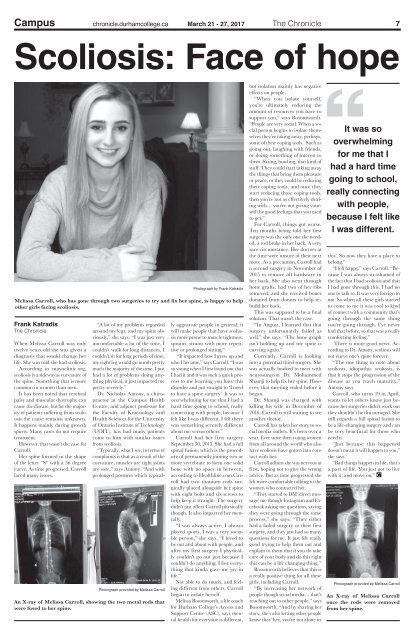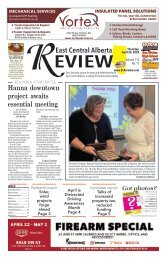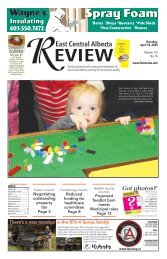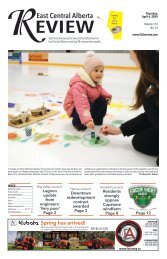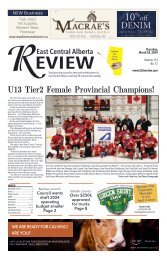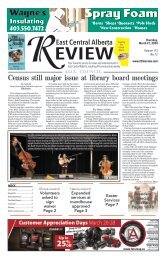You also want an ePaper? Increase the reach of your titles
YUMPU automatically turns print PDFs into web optimized ePapers that Google loves.
Campus chronicle.durhamcollege.ca March 21 - 27, 2017 The Chronicle 7<br />
Scoliosis: Face of hope<br />
Frank Katradis<br />
The Chronicle<br />
When Melissa Carroll was only<br />
twelve years old she was given a<br />
diagnosis that would change her<br />
life. She was told she had scoliosis.<br />
According to mayoclinic.org,<br />
scoliosis is a sidewayas curvature of<br />
the spine. Something that is more<br />
common in women than men.<br />
It has been noted that cerebral<br />
palsy and muscular dystrophy can<br />
cause the disease, but for the majority<br />
of patients suffering from scoliosis<br />
the cause remains unknown.<br />
It happens mainly during growth<br />
spurts. Many cases do not require<br />
treatment.<br />
However, that wasn’t the case for<br />
Carroll.<br />
Her spine formed in the shape<br />
of the letter “S” with a 56 degree<br />
curve. As time progressed, Carroll<br />
faced many issues.<br />
Photograph by Frank Katradis<br />
Melissa Carroll, who has gone through two surgeries to try and fix her spine, is happy to help<br />
other girls facing scoliosis.<br />
Photograph provided by Melissa Carroll<br />
An X-ray of Melissa Carroll, showing the two metal rods that<br />
were fused to her spine.<br />
“A lot of my problems regarded<br />
around my legs, and my spine obviously,”<br />
she says. “I was just very<br />
uncomfortable a lot of the time. I<br />
couldn’t walk for long distances, I<br />
couldn’t sit for long periods of time,<br />
my right leg would go numb pretty<br />
much the majority of the time. I just<br />
had a lot of problems doing anything<br />
physical, it just impacted me<br />
pretty severely.”<br />
Dr. Nicholas Antony, a chiropractor<br />
at the Campus Health<br />
Centre, and adjunct professor for<br />
the Faculty of Kinesiology and<br />
Health Sciences for the University<br />
of Ontario Institute of Technology<br />
(UOIT), has had many patients<br />
come to him with similar issues<br />
from scoliosis.<br />
“Typically, what I see, in terms of<br />
complaints is that as a result of the<br />
curvature, muscles are tight joints<br />
are sore,” says Antony. “And with<br />
prolonged postures which typically<br />
aggravate people in general, it<br />
will make people that have scoliosis<br />
more prone to muscle tightness,<br />
sprains, strains with more repetitive<br />
or prolonged sitting.”<br />
“It impacted how I grew up and<br />
who I became,” says Carroll. “I was<br />
so young when I first found out that<br />
I had it and it was such a quick process<br />
to me learning you have this<br />
disorder and just straight to ‘I need<br />
to have a spine surgery’. It was so<br />
overwhelming for me that I had a<br />
hard time going to school, really<br />
connecting with people, because I<br />
felt like I was different, I felt there<br />
was something severely different<br />
about me versus others.”<br />
Carroll had her first surgery<br />
September 30, 2013. She had a full<br />
spinal fusion, which is the procedure<br />
of permanently joining two or<br />
more vertebrate to form one solid<br />
bone with no space in between,<br />
according to Healthline.com.Carroll<br />
had two titanium rods surgically<br />
placed alongside her spine<br />
with eight bolts and six screws to<br />
help keep it straight. The surgery<br />
didn’t just affect Carroll physically<br />
though. It also impacted her mentally.<br />
“I was always active, I always<br />
played sports, I was a very sociable<br />
person,” she says. “I loved to<br />
be out and about with people, and<br />
after my first surgery I physically<br />
couldn’t go out just because I<br />
couldn’t do anything. I lost everything<br />
that kinda gave me joy in<br />
life.”<br />
Not able to do much, and feeling<br />
different from others, Carroll<br />
began to isolate herself.<br />
Melissa Bosomworth, a life coach<br />
for Durham College’s Access and<br />
Support Centre (ASC), says mental<br />
health for everyone is different,<br />
but isolation mainly has negative<br />
effects on people.<br />
“When you isolate yourself,<br />
you’re ultimately reducing the<br />
amount of resources you have to<br />
support you,” says Bosomworth.<br />
“People are very social. When a social<br />
person begins to isolate themselves<br />
they’re taking away, perhaps,<br />
some of their coping tools. Such as<br />
going out, laughing with friends,<br />
or doing something of interest to<br />
them. Skiing, bowling, that kind of<br />
stuff. They could start taking away<br />
the things that bring them pleasure<br />
or peace, or they could be reducing<br />
their coping tools, and once they<br />
start reducing those coping tools,<br />
then you’re not as effectively dealing<br />
with… you’re not giving yourself<br />
the good feelings that you used<br />
to get.”<br />
For Carroll, things got worse.<br />
Ten months being told her first<br />
surgery was the only one she needed,<br />
a rod broke in her back. A very<br />
rare circumstance. Her doctors at<br />
the time were unsure of their next<br />
move. As a precaution, Carroll had<br />
a second surgery in November of<br />
20<strong>15</strong> to remove all hardware in<br />
her back. She also went through<br />
bone grafts, had two of her ribs<br />
removed, and she received bones<br />
donated from donors to help rebuild<br />
her back.<br />
This was supposed to be a final<br />
solution. That wasn’t the case.<br />
“In August, I learned that that<br />
surgery unfortunately failed as<br />
well.” she says. “The bone graph<br />
isn’t holding up and my spine is<br />
curving again.”<br />
Currently, Carroll is looking<br />
into a potential third surgery. She<br />
was actually booked to meet with<br />
neurosurgeon Dr. Mohammed<br />
Shamji to help fix her spine. However,<br />
that meeting ended before it<br />
began.<br />
Dr. Shamji was charged with<br />
killing his wife in December of<br />
20<strong>16</strong>. Carroll is still waiting to see<br />
another doctor.<br />
Carroll has taken her story to social<br />
media outlets. It’s been over a<br />
year. Ever since then young women<br />
from all around the world who also<br />
have scoliosis have gotten into contact<br />
with her.<br />
Carroll admits she was nervous at<br />
first, hoping not to give the wrong<br />
advice. But as time progressed she<br />
felt more comfortable talking to the<br />
women who contacted her.<br />
“They started to DM (direct message)<br />
me though Instagram and Facebook<br />
asking me questions, saying<br />
they were going through the same<br />
process,” she says. “They either<br />
had a failed surgery or their first<br />
surgery, and they just had so many<br />
questions for me. It just felt really<br />
good trying to help them out and<br />
explain to them that if you do take<br />
care of your body and do this right<br />
this can be a life changing thing.”<br />
Bosomworth believes that this is<br />
a really positive thing for all these<br />
girls, including Carroll.<br />
“By increasing her network of<br />
people though social media… that’s<br />
reaching out to other people,” says<br />
Bosomworth. “And by sharing her<br />
story, she’s also letting other people<br />
know that ‘hey, you’re not alone in<br />
It was so<br />
overwhelming<br />
for me that I<br />
had a hard time<br />
going to school,<br />
really connecting<br />
with people,<br />
because I felt like<br />
I was different.<br />
this’. So now they have a place to<br />
belong.”<br />
“I felt happy,” says Carroll. “Because<br />
I was always so ashamed of<br />
the fact that I had scoliosis and that<br />
I had gone through this. I had no<br />
one to talk to. It was very foreign to<br />
me. So when all these girls started<br />
to come to me it was cool to kind<br />
of connect with a community that’s<br />
going through the same thing<br />
you’re going through. I’ve never<br />
had that before, so that was a really<br />
comforting feeling.”<br />
There is more good news. According<br />
to Dr. Antony, scoliosis will<br />
not curve one’s spine forever.<br />
“The one thing to note about<br />
scoliosis, idiopathic scoliosis, is<br />
that it stops the progression of the<br />
disease as you reach maturity,”<br />
Antony says.<br />
Carroll, who turns 19 in April,<br />
wants to let others know just because<br />
her surgeries didn’t work out<br />
they shouldn’t be discouraged. She<br />
still regards a full spinal fusion to<br />
be a life-changing surgery and can<br />
be very beneficial for those who<br />
need it.<br />
“Just because this happened<br />
doesn’t mean it will happen to you,”<br />
she says.<br />
“Bad things happen in life, that’s<br />
a part of life. You just got to live<br />
with it, and move on.”<br />
Photograph provided by Melissa Carroll<br />
An X-ray of Melissa Carroll<br />
once the rods were removed<br />
from her spine.


